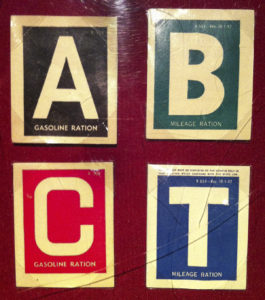
I was having a casual discussion with a friend about recent political events that have transpired in the U.S and it made me think about the fragility of international relations and our interdependence on earthly resources. Immediately I was drawn back to 1942 when the government started rationing for gasoline following their entry into the war.
Gas was arguably the most consumed resource of the war, with transport taking up the lion’s share of its usage. However, it wasn’t particularly the shortage of gas that forced the government’s hand; it was the sudden and acute shortage of rubber.
At the time, America got 90% of its raw rubber from the plantations in Dutch East Indies. Unfortunately, Japan got there first and halted supplies to the U.S. Soon everyone from President Franklin D. Roosevelt to the local schools got involved in promoting and collecting unused rubber from the general public. Volunteer campaigns gathered everything from tires to raincoats to rubber shoes and everything in between.
Despite their best efforts, the shortage grew severe by each passing day. Eventually, on 15th May 1942, an intricate system of policies was devised, and the rationing of gasoline began. The motive; reduced gasoline consumption will result in lesser tire wear, leading to decreased demand for new tires, thereby saving rubber. This was complemented by a nation-wide traffic speed restriction of 35 mph.
Initially, 18 eastern states were taken under the umbrella of this drive that was moderated by the Federal Office of Price Administration. Under this drive, automobile owners had to visit OPA offices to register and receive specific windshield stickers which entitled them a fixed amount of gasoline per week. These stickers had several tiers, labeled with different alphabets, entirely dependent upon the occupation status of the automobile owner.
Sticker “A” was most commonly used and issued to the general public. This entitled the owner between 3-5 gallons of gasoline per week.
Sticker “B” was for business owners and came with 8 gallons per week.
Sticker “C” catered to 17 different occupations. People from dentists, nurses, ministers, farm workers, military personnel and more.
Sticker “M” was for motorcyclists that included drivers working in the delivery business.
Sticker “T” was used by Truck drivers and granted unlimited gasoline supply
Sticker ‘R” was consumed by vehicles used for farming; also unlimited supply.
Sticker “E” granted ambulances, police and fire vehicles with unlimited supply.
Sticker “X” was probably the most controversial one since it was for VIPs – a hotly contested title which also came with an unlimited supply of gasoline.
Despite this elaborate system, an extreme shortage of gas was faced in 1944, even though this scheme had spread nationwide by December of 1942. This forced drastic changes in the entitled gasoline per week of most of the stickers; with owners of sticker “A” getting the shortest end of the stick with barely 2 gallons per week.